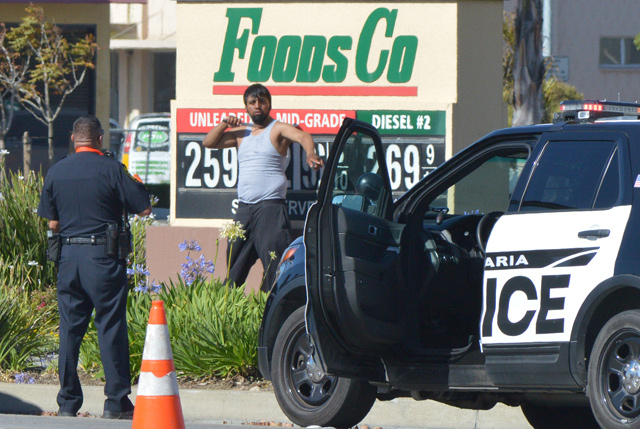Family Sues over Fatal Shooting of Mentally Ill Man
Attorney Argues Officers Could Have Used Shields and Tasers

Attorneys for the family of a 31-year-old man who was shot and killed by police officers two weeks ago filed a wrongful death complaint against the Santa Maria Police Department. The lawsuit seeks $3 million in damages and demands that the department better train its personnel in the use of lethal force.
On Wednesday morning, July 20, police responded to the 1400 block of South Broadway, where Javier Gaona reportedly left Wells Fargo distressed and wielding what was described as an eight-inch knife. Within about 15 minutes, more than a dozen peace officers and their BearCat armored vehicle arrived on scene. For half an hour, officers negotiated with Gaona while he yelled back, asking them to kill him and holding the knife to his throat. Police fired 15 beanbag rounds. Gaona fell. He got back up. He then lunged at the officers, three of whom fired as many as 15 shots. Gaona later died at the hospital.
“It was a static situation,” said attorney Eric Schweitzer, who has represented a number of families of police shooting victims. “This was not a riot. This was not a guy being civilly disobedient. They had time on their hands. What was the rush?”
Immediately after the incident, Santa Maria Police Chief Ralph Martin told reporters an FBI negotiator spoke to Gaona but that he had stopped talking with the agent. He clearly intended to harm himself or others, Martin said. Last week, Martin declined a follow-up interview, citing the pending litigation. District Attorney Joyce Dudley said her office would conduct an investigation but that it usually takes months for her office to even receive the police reports.
Originally from Michoacán, Mexico, Gaona had been in Santa Maria for 11 years. He lived with his mom and dad and two sisters. He had six prior arrests, all for misdemeanors, and had spent time in and out of County Jail. According to Schweitzer, Gaona suffered from bouts of depression, at times not leaving his bedroom for a week, but he was never aggressive. Whether or not he was ever diagnosed, Schweitzer said, is still to be determined. “It really doesn’t matter as to the case at hand,” he said. He rejected the theory Gaona wanted to commit suicide by cop.
“If they had shields and Tasers in place,” this wouldn’t have happened, Schweitzer added. He argued Gaona was 18-20 feet away from police, and “you don’t use deadly force under any circumstances outside of 21 feet unless he is armed with a firearm.”
This month, a new California law went into effect requiring that police academies increase their mental-illness training from six hours to 15. A second component sets up mental-health training sessions, covering mental illness, intellectual disabilities, substance-abuse disorders, and tactical communication. It is not mandatory, but departments can order that their officers complete the sessions. The Santa Barbara Sheriff’s Office hopes to have 100 percent of its personnel trained in crisis intervention by next April.
Last week, the Blue Courage program — a two-day training session that instructs deputies how to handle people exhibiting signs of mental distress — was offered to Santa Barbara County law enforcement. Undersheriff Bernard Melekian called the course “as interesting and as helpful” as he had hoped.
In 2000, Melekian, then Pasadena’s police chief, testified before Congress about officers interacting with the mentally ill. He said police were “ill-prepared and ill-equipped” to deal with such issues. “I came into this business for a variety of reasons, not the least of which was to help people. And I find that with regard to this issue, I am unable to do my job,” Melekian said.
“I cannot help the woman who comes into my police station in fear for her life, for the life of her children, because her husband hears voices and views her as some sort of demonic creature. I cannot help the people who are afraid of their neighbors or the homeless person walking down the street.
“This issue has been, in my opinion, improperly framed to be whether one is for or against civil liberties. There is nothing civil about jail. There is nothing civil about living under a bridge or in an alley,” he continued. “Why have police officers in this country become the first responders and, in effect, placed in the position of becoming armed social workers?”
Some progress has been made, Melekian said. Awareness of mental illness is infinitely better, and training for deputies has improved, he said. “Quite honestly the solution to this problem is not to figure out which weapons are most effective but figuring out how to get people into treatment.”



